Part 1 – Outline your beliefs
Part 2 – Finding your child’s preferred “intelligence(s)” and learning style
Part 3 – Choosing a learning style
Part 4 – Locating the curriculum/program and finding resources
Part 5 – Adapting/Modifying the curriculum
Part 6 – Mapping out the year
Part 7 – Mapping out the months
Part 8 – Planning the Week
Part 9 – Planning Your Day
Now that the bulk of the planning is done, another step must be considered.
How will you know if your child is progressing? How will you know if you’re on the right track? How will you know if all of your planning, adapting, and modifying is even working? How will you know what to plan next?
The answers come down to two important sets of information: assessments and evaluations.
First, let’s look at the difference between assessments and evaluations, as they are not one and the same, even though the terms are often used interchangeably.
Defining Assessment and Evaluation
Assessments are ongoing collections of information. It’s what you do daily—before, during, and after an activity. The methods of gathering information vary:
- Checklists
- Anecdotal notes based on observations
- Charts
- Pieces of writing
- Interviews/conferences
- Projects
- Self-assessments
- Developmental continuum
- Etc.
Evaluations are what you do with the data you collect. You examine it and then come to a conclusion about how your child is progressing over a longer period of time. The findings then help you with future planning—such as when you plan your next block of learning.
Evaluations come in the form of:
- Tests (parent- or even child-created)
- Exams (provincial/state-administered)
- Rubrics (although, if well-used, rubrics can be great assessment tools)
While it may sound very scientific, you do this automatically. Throughout the day, you most likely observe your child (assessment) and then form a judgment about how they’re doing on that task (evaluation).
An example of how to use assessments and evaluations
Your child is involved in a craft activity, and you notice that they’re trying to grasp the scissors, which they were never able to do until today. Excitedly, you offer them a sheet of paper and notice that they’re attempting to cut it, even though they mostly miss the paper and have trouble holding both the sheet and the scissors simultaneously. You notice that they’re frustrated and upset about being unable to do it. All of these observations are assessments of the situation. You haven’t intervened, and you haven’t even made a judgment about it. You’re simply in the moment, observing what you see.
The next step, which often happens simultaneously, is that you decide that you probably set the activity at a skill level too difficult for them. Holding the scissors was apparently enough for today, but you had them try with paper immediately. You’ve just evaluated the situation. Consequently, you decide that you’ll play a little game with the scissors alone tomorrow. You’ll have them practice cutting the air by opening and closing the scissors, accompanied by a little song. What you did here is change/adapt the activity to better meet your child’s skill level—all because of the assessment and evaluation made.
Assessments and evaluations help you alter your plans to better meet the abilities of your child. Without them, you’d be planning and executing Pinterest-inspired activities all year long just because they’re cute.
Evaluation of Learning
Your province/state most likely has a policy on evaluating learning. You can find it online where you located your province/state’s curriculum/program (part 4).
Depending on location, some homeschoolers are required to keep specific types of records of their child’s progress. Always check with your provincial/state laws. Regardless, I always say to be prepared with records. In case anyone ever asks, you have a collection of data to share as evidence of the wonderful job you and your child are doing!
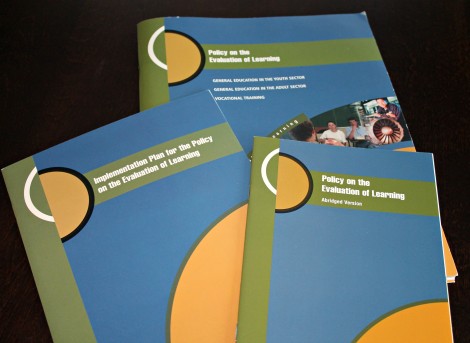
These booklets are the Quebec Policy on the Evaluation of Learning. They contain a lot of jargon that basically says that our province has a law evaluating all learners in the public school system. They have a small mention that students with “special needs” are permitted to have “adaptive evaluation conditions.”
Setting goals for your neurodivergent or disabled child
In part 1, when thought about your philosophy of education, you considered overall goals for your family and child. In part 5, when you began looking at how to make adaptations/ modifications for your child, you narrowed in on specific goals for them.
When making assessments, your goals will remain the same, but the process of getting there will alter—sometimes daily—depending on the data you collect on your child.
If you haven’t formally thought about goals yet, find your Homeschool Reflections journal and get cracking. It’s not too late to think about these questions. In fact, you should constantly be returning to them as you plan, execute and then assess the activities on a daily basis.
When goal-setting, plan with the end in mind.
Ask yourself:
- What is the overall homeschooling goal for my neurodivergent/disabled child?
- What are my child’s goals for themselves for the next 3 months?
- What will it look like when they’ve achieved those goals?
- What are my goals for the next 3 months for my child?
- What are my child’s goals for themselves for the next 3 months?
- What will it look like when they’ve achieved those goals?
The questions above get you thinking about the final outcome, which is what you hope will be accomplished by the end of the learning block.
Then, ask yourself:
- What are my child’s top strengths?
- What can we continue to build on?
- What are my child’s learning style and dominant intelligence? (see part 2)
- Based on what’s already outlined for the year, what does my child already know how to do?
- What areas require specific attention?
- What does my child need from me to develop these skills in the next 3 months?
- What steps will I take to help them get there?
Don’t forget to incorporate points from the most recent evaluation given to you by your child’s specialists. Weave those suggestions into your responses to the questions above.
Important note: Be sure the goals are not ableist in nature. The idea is to create goals that reduce or remove barriers to learning, not to “fix” or change the child. Further, goals should always be set with and not for the child.
How to set up a simple assessment system
I suggest keeping things simple.
I’ll only do something if it’s easy to set up and manage. And nothing works better for me than simply jotting down notes in my planner. In part 9, I showed you how I insert a loose-leaf sheet between my weekly planner sheets for weekly anecdotal notes. This way, I don’t need to feel pressured to write daily—even though I do add a little something in there each day.
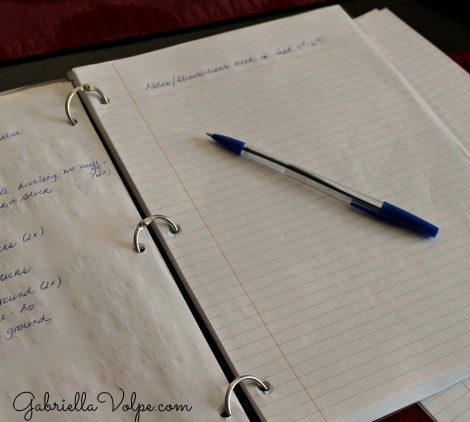
I add loose-leaf sheets for observations into my planner, which is held together by ring binders. This way, I can effortlessly record and easily remove the sheets to add to a portfolio later.
I like to be mindful during the activity my son and I are engaged in; therefore, I make an effort somewhere later in the day to write a few notes about what I observed. I can’t help but make judgments and notes about how to modify it for him the next time. Going that step further is OK, but you don’t need to at this point.
Simply jot down what you noticed:
- What your child did (task)
- How they reacted to the activity
If you want to get fancy about it, you can find all kinds of neat checklists and charts online. While this is tempting to do since everything appears organized, the problem is they rarely match your child’s skill level, which will tempt you to compare them to the standards (and isn’t the whole reason you’re homeschooling because you want your child to learn at their own pace?) Unless it’s a rubric or developmental continuum, I would suggest keeping charts for evaluation purposes at the end of a learning block.
If you don’t write notes on blank sheets of paper because you feel they’re too unstructured, then print up a chart! I have included some links to free printables in the resources below. The important thing is to collect data. The method by which you do it is completely up to you.
Using assessment tools for planning
Sometimes, however, I will agree that assessment tools make great guides for planning/teaching as they can nudge you in the direction of what you might teach your child next. If you glance them over, find one that your child is closest to in skill level (not in grade level) and use it for planning. You can gain great value from assessment tools.
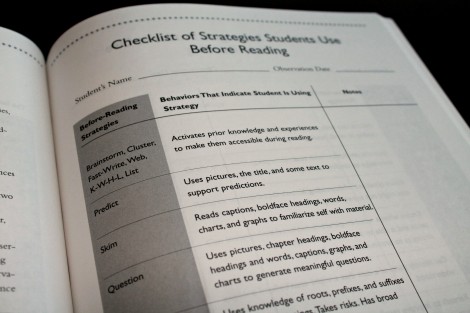
Checklists like this one can help guide your planning/teaching in addition to being a document in which data gets recorded. (This book is listed in the resources.)
I advise you not to get too attached (or disheartened) by the skill/ grade level indicated on the checklists you find. Even older children benefit from the preschool tools—if that is where your child is at. Simply white out the grade level and use the tool as needed.
How to set up a simple evaluation system
Depending on where you live, there are different laws about evaluations and who administers them. Look into the legal aspect of this as a third party may be required to look over your child’s portfolio and sign an evaluation form in the process.
I think it’s a great idea for parents to look things over at the end of a block of time, regardless of whether your child’s school board is going to send someone, whether you hire someone privately, or not (all depending on the laws in your province/state).
This is an appropriate time to use the forms that you find online (don’t create them—the wheel has been invented). I have listed some below in the resources for you.
Take some time at the end of a season/term to evaluate what your child has done over the span of the last several months.
Ask yourself:
- How does my child feel about what they accomplished?
- What do they want to learn next?
- What has my child acquired?
- What should we continue to focus on?
- Can we move on to the next level?
- How can we change the tasks, materials, etc., to better suit their needs?
- What are my goals for the next block of time? (go back to the questions above in the goal-setting section)
About the developmental continuum and/or the rubric
I’m not a fan of formal testing, so I prefer to use rubrics, which are actually developmental continua. They can be used to assess periodically as well as to evaluate at the end of a learning block.
You are already familiar with developmental continua. They are the charts you’ve been bombarded with since your child’s diagnosis. They contrast milestones and birth age. Only, being wise as you are, you’ve learned to replace the birth age with the developmental stage.
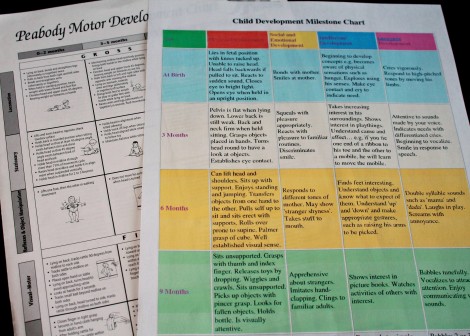
These motor development charts are continua that let you know what precedes a certain skill/milestone and what follows it. (The colorful milestone printables are available in the resources below.)
Developmental continua can also be used for assessing academic progress. It allows you to connect assessment to teaching.
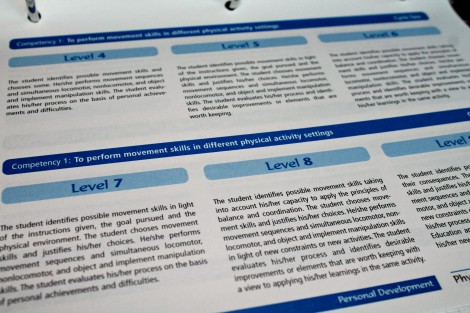
This is a sample of the Quebec continua that is provided by the Ministry of Education as a means to support the educational approaches of teachers. It shows all of the learning a student is to acquire from grade 1 to 6 for each subject. This one is the physical education continuum. Note: “Levels” do not stand for grade levels but levels of competency instead. For example, the Phys. Ed continuum for “to perform movement skills in different physical settings” has a total of 9 competency levels that a child must achieve by the time they complete elementary school.
Rubrics are a type of continuum that can also be used to score the child’s progress at the end of a task or learning block. They give a formal analysis of where the child is at and where they need to go next.
The wording in a rubric is often subject- and task-specific, whereas the wording on a developmental continuum is a little more general as it spans over the course of a child’s year or even lifetime (as is the case for those milestone charts).
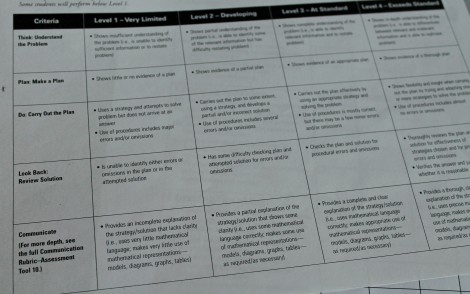
A rubric is a scale in the form of a chart. It tables criteria with outcomes and scores them along with a subject—or task-specific continuum.
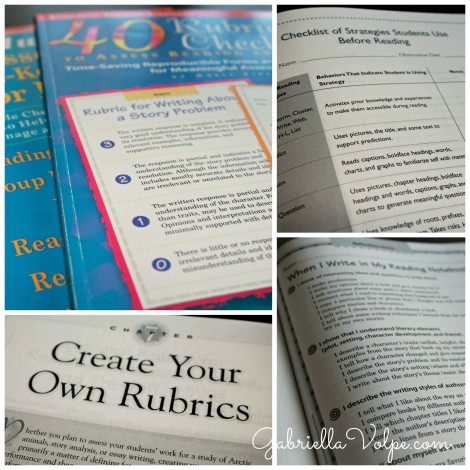
These books (listed in the resources) have a mix of checklists, rubrics as well as teaching material to get you started. One of them even shows you how to create your own rubrics. While they’re intended for classroom use, I find they have great value for older homeschoolers. (If you’re in the Montreal area and would like to borrow mine, I’d be more than happy to lend these to you.)
Assembling an assessment and evaluation kit
The fancy word for assessment and evaluation kit is a portfolio.
You include all of the assessments (ex: notes, charts, etc.) and all of the evaluations (ex: rubrics, tests/exams, etc.) as well as sample works and projects into one beautiful collection.
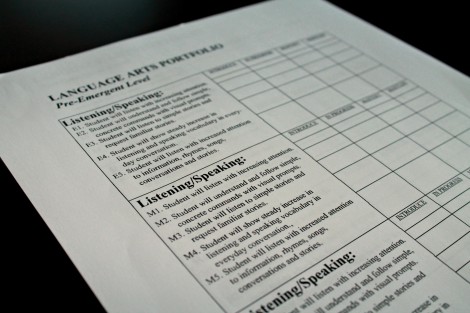
Checklists, if you are using any, can be added to a portfolio later.
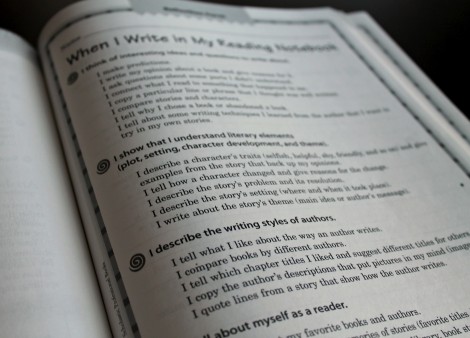
Self-assessments can also be added to a portfolio. If you have a neurodivergent or disabled child, you may need to complete these along with your child. (This book is listed in the resources below.)
The resources contain wonderful links to portfolio creation. There is no right or wrong way to put together a portfolio. Allow your child to be a part of the process. If they are able to, let them select what samples they’d like to include. Have them personalize it and make it their own. Then, display it on your coffee table for everyone to enjoy!
How do you keep track of assessments and evaluations? Do you already keep a portfolio?
Resources
Assessments & Evaluations
First Steps Reading Developmental Continuum – This First Steps tool was developed in Australia but is used in Canada and the USA as well.
40 Rubrics and Checklists to Assess Reading & Writing, grades 3-6 – Book intended for classroom use, but if you’re looking for some ready-made checklists and rubrics, this is a great resource
35 Must-Have Assessment & Record-Keeping Forms for Reading – grades 4-8 – Book intended for classroom use, but if you’re looking for some ready-made checklists for portfolio purposes, this is a good one to have
Assessment & Evaluations Pinterest Board – My ever-growing Pinterest board on this topic
Portfolios
Step-by-step guide to building a portfolio
You are officially ready to plan your homeschool year! I am available for individual consultations if you need any guidance along the way. Together, we can dig deeper into your child’s/family’s specific needs.
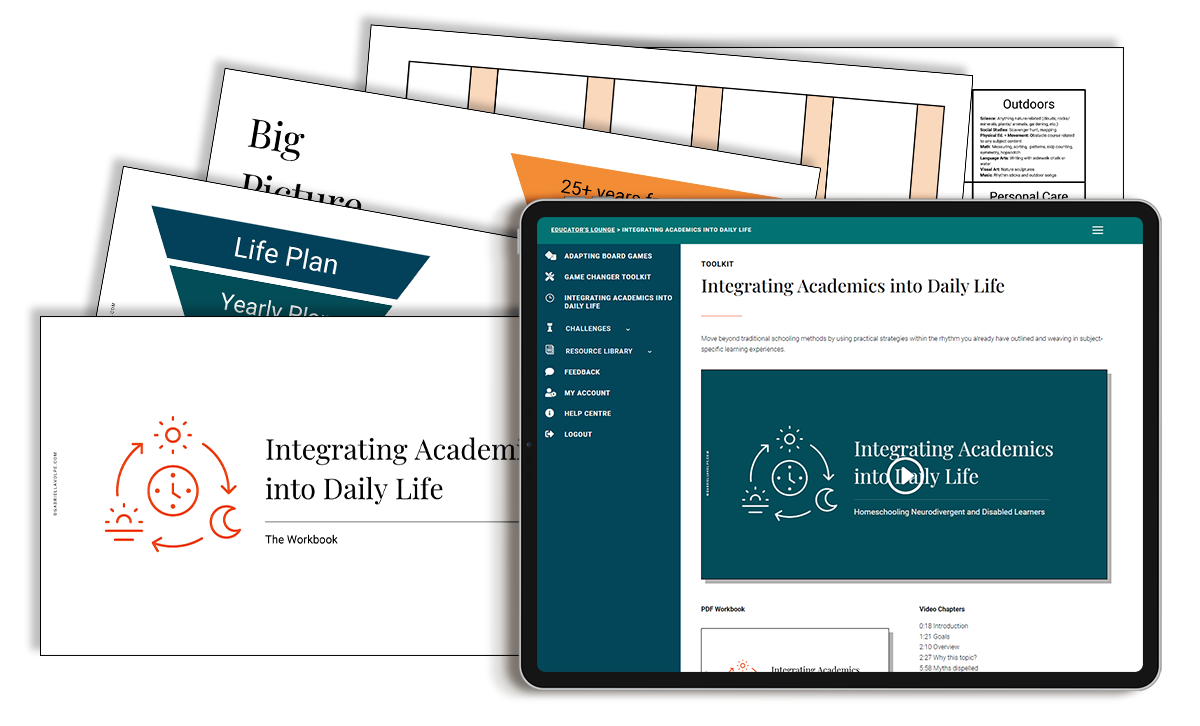
Integrating Academics into Daily Life Workshop
Discover how to integrate academics into daily life. For homeschoolers of neurodivergent and disabled learners.

0 Comments